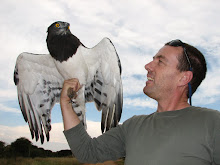A weekend Bird Atlasing in the Memel area
11th and 12th October 2014
 |
| Normandien Pass |
My friends Niall and his wife Debby arrived in Memel on the
Saturday morning to do some bird atlasing and road trapping to for birds of
prey. After watching a Red-chested Sparrowhawk circling over the field, we set
off up to Normandien Pass, some 45 kilometers away and began logging birds in
each different pentad, in this case an 8x8 kilometer square.
After a few kilometers we were rewarded with the beautiful
site of a pair of Blue Cranes, South Africa’s National Bird! These two looked
like they had pared up to breed. Some few k’s later we really lucked out and
came across a pair of Grey-crowned Cranes!! What a treat, Cranes in Africa and
the world are severely endangered by a multitude of factors, the main one being
land use by farmers and settlements, too frequent grassland burning, direct
human disturbance, then collision with powerlines and fences, not to mention
poisoning where grain is left for wildfowl which is then eaten by cranes.
 |
| Mullers Pass |
But what followed next was one of those very rare
experiences you only read about, when we came across a flock of 9 Blue Cranes
with a single Wattled Crane with them!! A 3 Crane day and it was only 10 am!!
All 3 of SA’s crane species!!
Buoyed by this we checked on 3 distant Verreaux’s Eagle nests
on the cliffs, one looked like there was a young fledged bird sitting, but too
far to be sure.
Verreaux’s Eagles have a hard time in the area being
persecuted by sheep farmers concerned for their lambs. No eagle will catch live
healthy lambs to the extent that it becomes a problem for farmers, if there are
hares, dassies, moles, mongoose, guinea fowl, and tortoises in healthy numbers.
If preys habitat is modified to suit sheep, then the eagle is forced into preying
on lambs in the absence of its natural prey species.
 |
| Kranzkop and the vast grasslands |
At the higher elevation near the pass we began to see
Long-billed Pipits and another endemic, Long-billed Lark. But the best was a
Yellow-breasted Pipit on the side of the road, a male, just coming into
breeding plumage. This critically endangered endemic was the first time I have
really seen it to be certain and it turned out to warrant filling in a regional
rarities form!
We carried on getting some nice species for the rest of the
morning including the endemic Ground Woodpecker, Mountain Wheatear, Cape
Long-claw, Spike-heeled Lark and Cloud Cisticola. We came across a Jackal
Buzzard and tried to get a trap down to ring him, but he took off.
 |
| White-throated Swallow |
In the afternoon, we drove round the local and famous Seekoevlei
(Hippo Pan) Nature Reserve. We came across 6 endemic Blue Korhaan in the
reserve, the first we had seen, possibly because the grass was in good
condition unlike some of the more over grazed and over burnt farmlands.
 We stopped at a bridge which annually hosts several hundred
migratory breeding South African Cliff Swallows. So we got a net set in place
and managed to catch and ring a few, including a cracking adult White-throated
Swallow. Very little is known about where these two species migrate to so
hopefully one day we may get a ring recovery.
We stopped at a bridge which annually hosts several hundred
migratory breeding South African Cliff Swallows. So we got a net set in place
and managed to catch and ring a few, including a cracking adult White-throated
Swallow. Very little is known about where these two species migrate to so
hopefully one day we may get a ring recovery. |
| SA Cliff Swallow |
 The following day we set off to Mullers pass, and over the
morning we did it again and found all three Crane species!! On this route we
were lucky to find 3 endemic Buff-streaked Chats and a covey of several endemic
Grey-winged Francolins. We then drove up onto a vast grassland area to Kranzkop
Mountain. Here the grassland swept away to the horizon, truly spectacular
scenery. We were rewarded with a pair of Yellow-breasted Pipits this time a
The following day we set off to Mullers pass, and over the
morning we did it again and found all three Crane species!! On this route we
were lucky to find 3 endemic Buff-streaked Chats and a covey of several endemic
Grey-winged Francolins. We then drove up onto a vast grassland area to Kranzkop
Mountain. Here the grassland swept away to the horizon, truly spectacular
scenery. We were rewarded with a pair of Yellow-breasted Pipits this time a
cracking adult male in full breeding plumage with its mate, we have been very
lucky to have found 3 individuals of this species over 2 days. Further on near
the rocky slopes of the Kranzberg, we found a pair of another endemic, Sentinel
Rock Thrush, very nice birds too.
On the way back we were utterly astounded to see an adult
Martial Eagle soaring over the valley. What a find! This very persecuted and
vulnerable species is Africa’s largest eagle and only really seen in protected
areas and national parks, so to see one here in an area where there are a few
unsympathetic farmers was exceptional.


No comments:
Post a Comment